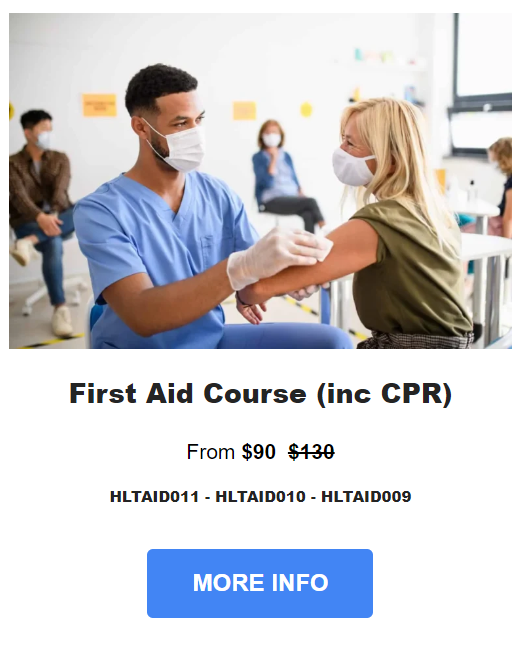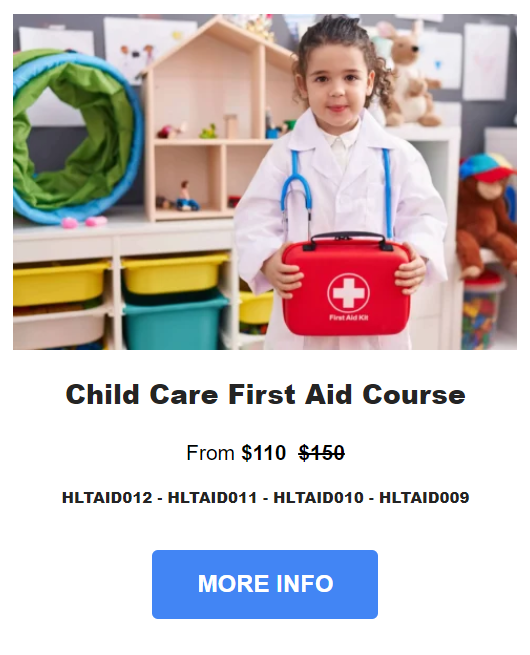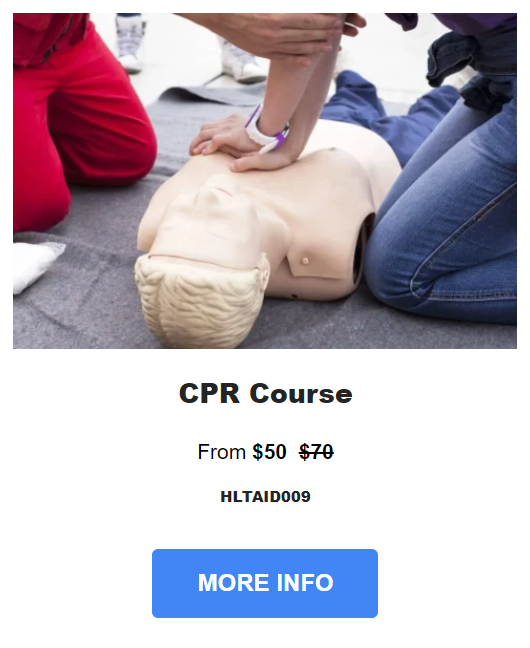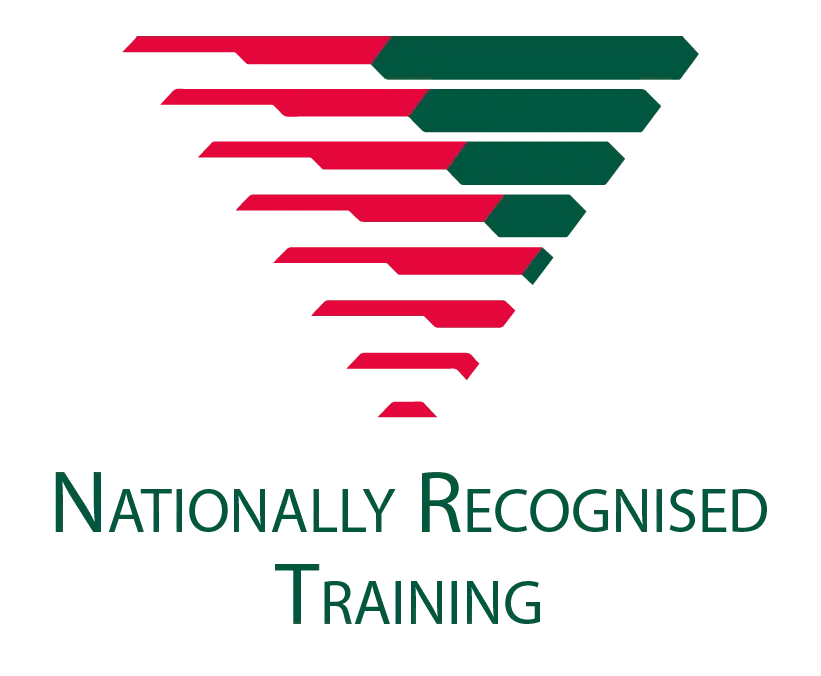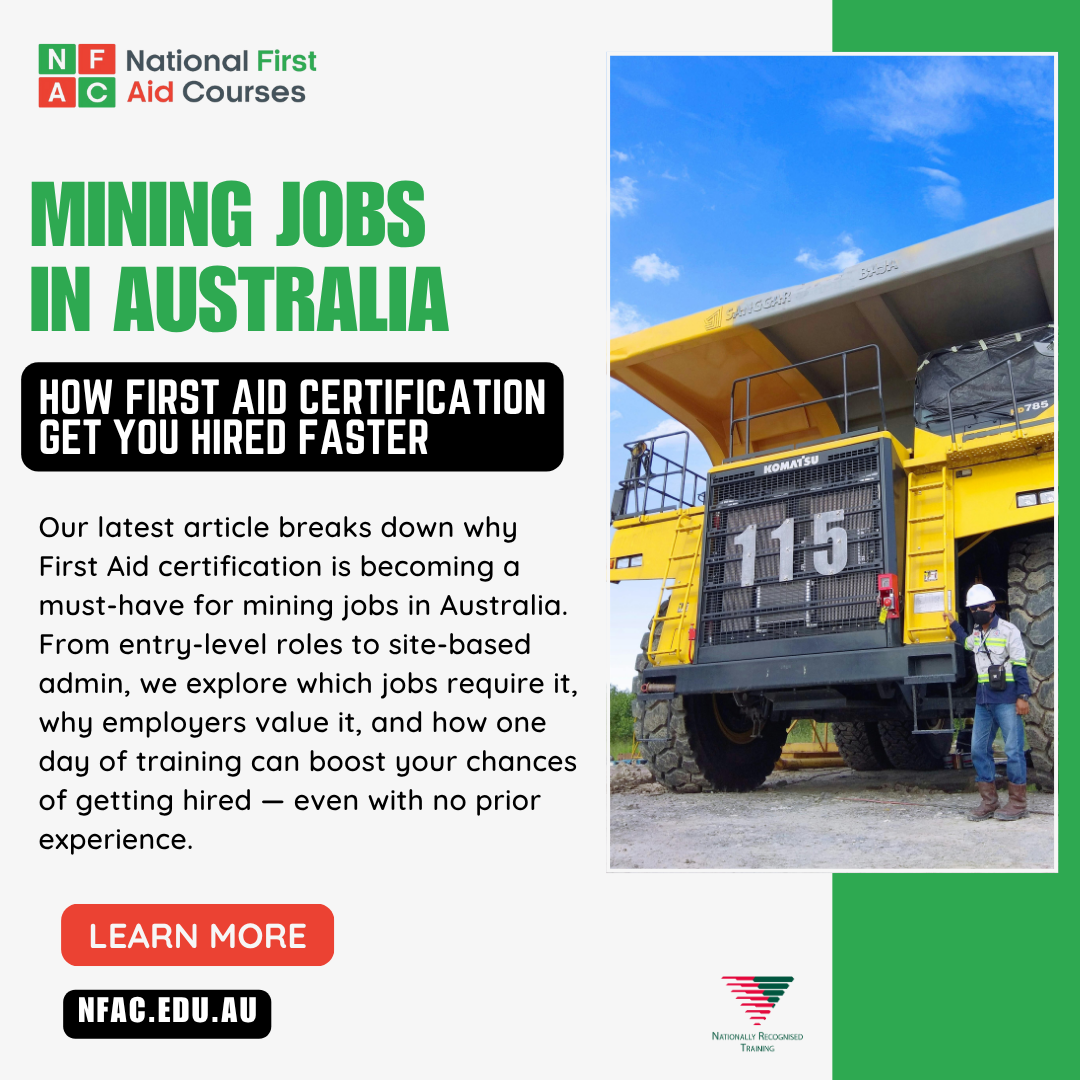
Key Takeaways for Mining Jobseekers
- • Applicable Across Roles: From drillers offsiders to site admins and dump truck operators, First Aid is now a common requirement.
- • HLTAID011 Accreditation: Secure the nationally recognised “Provide First Aid” certification that most mining employers ask for.
- • Face-to-Face Training Only: Hands-on, in-person instruction builds real confidence — just as remote mine sites demand.
- • Practice Real-World Scenarios: Simulate site incidents like machinery injuries and heat stroke under guidance from experienced trainers.
- • Same-Day Certificate: Complete the course and walk away with your official certificate on the very same day.
- • Avoid Automated Filters: Tick the First Aid box on SEEK and other job sites to prevent your application from being screened out.
Why You’re Probably Closer to Getting a Mining Job Than You Think
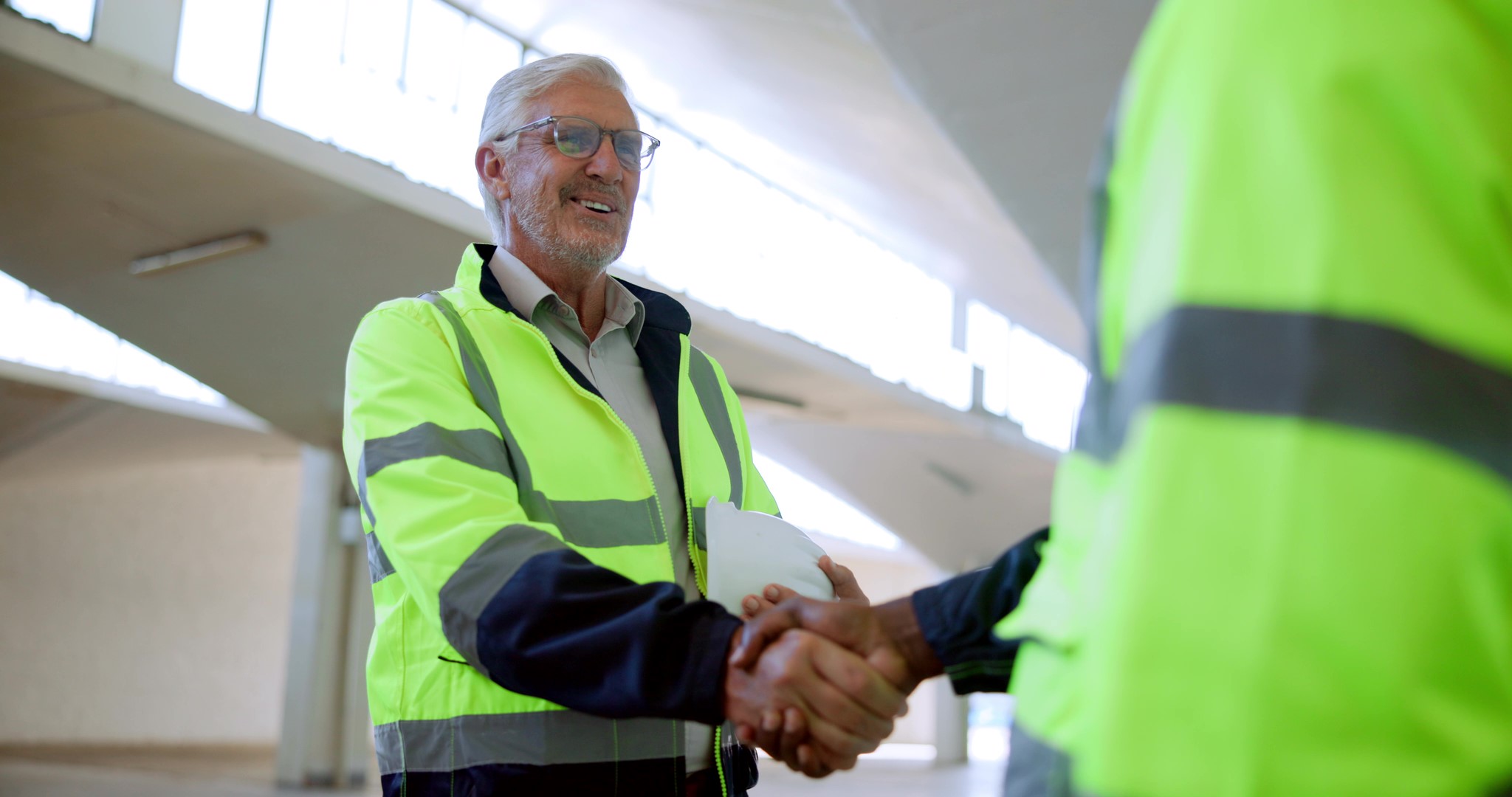
When people imagine mining jobs, they usually think of giant haul trucks, drilling rigs, or flying out to the Pilbara.
But here’s the reality: the mining industry in Australia needs more than just tradies and operators.
From admin roles to exploration assistants, there’s a wide range of jobs open to people who are ready to work — and many of them don’t require years of experience or a trade qualification.
If you’re willing to get the right tickets, you could be mine site-ready in a matter of days — not years.
In fact, we’ve been tracking mining jobs across Australia for some time now, and we noticed a pattern: many of them list First Aid certification as either required or strongly preferred.
So before you assume you’re not qualified, ask yourself this:
Are you actually unqualified — or just uncertified?
Whether you’re:
switching out of a trade that’s dried up,
burnt out in a city job and looking for FIFO,
or just curious what it takes to land your first mining gig…
The truth is, a First Aid Certificate might be the simplest way to move forward.
Trainer’s Insight
“We see people come through the door every week thinking First Aid is just for nurses or safety officers. But many high-risk industries like mining sites want everyone to be capable of helping in an emergency. Holding a First Aid certificate tells employers you’re prepared and ready to act when needed.”
First Aid Certificate: The Qualification Employers Prefer — Across All Kinds of Mining Jobs
You’d expect First Aid to matter for medics or emergency roles on site.
But what we’re seeing is different — employers are asking for it across a huge variety of positions, from office roles to field support to truck drivers.
We analysed live job ads for a variety of different mining roles in Australia — here’s what they show, and why First Aid certification matters:
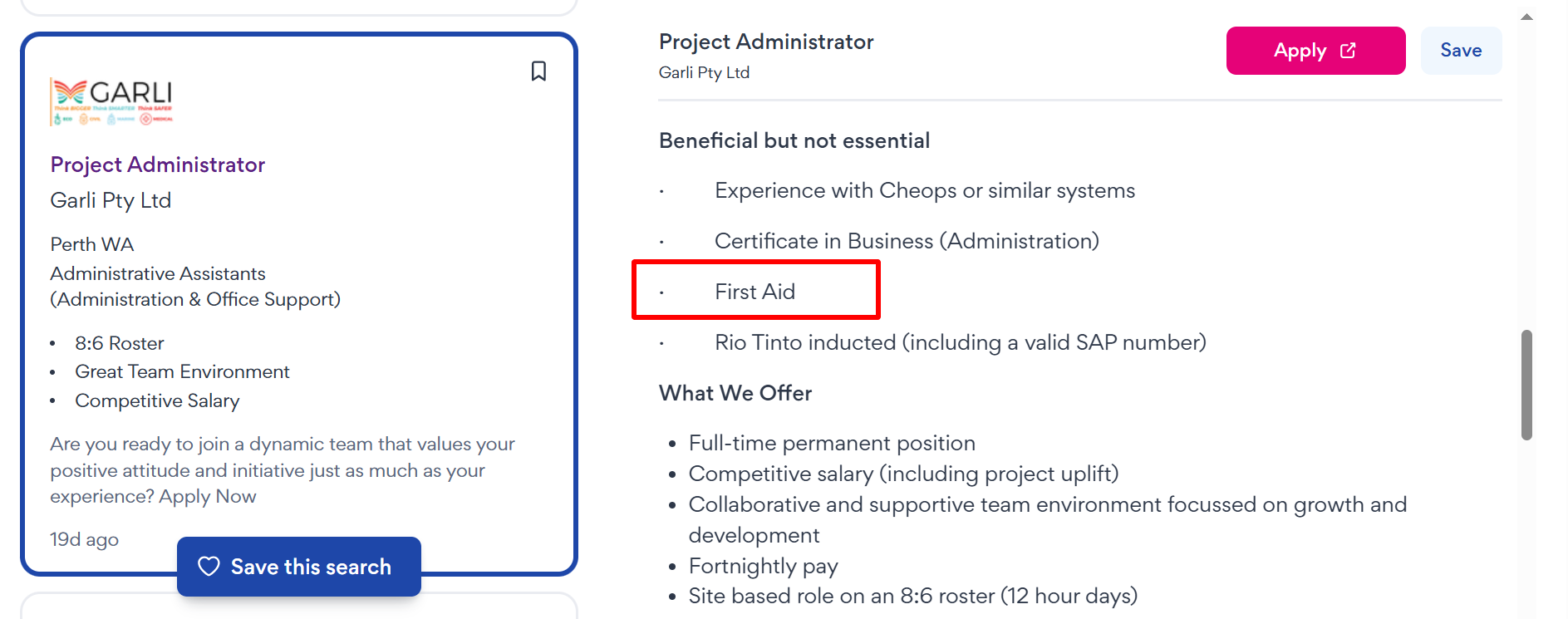
Project Administrator
“First Aid” listed as beneficial but not essential for an admin support role in mining.
At first glance, it’s just an admin job. So why First Aid?
Because even if you’re not in a hi-vis role, you’re often still based on site.
That means:
You could be first on the scene if someone collapses near the crib room.
You might be required to take part in site-wide safety inductions or emergency drills.
Admins often coordinate evacuations, keep incident logs, and support HSE staff.

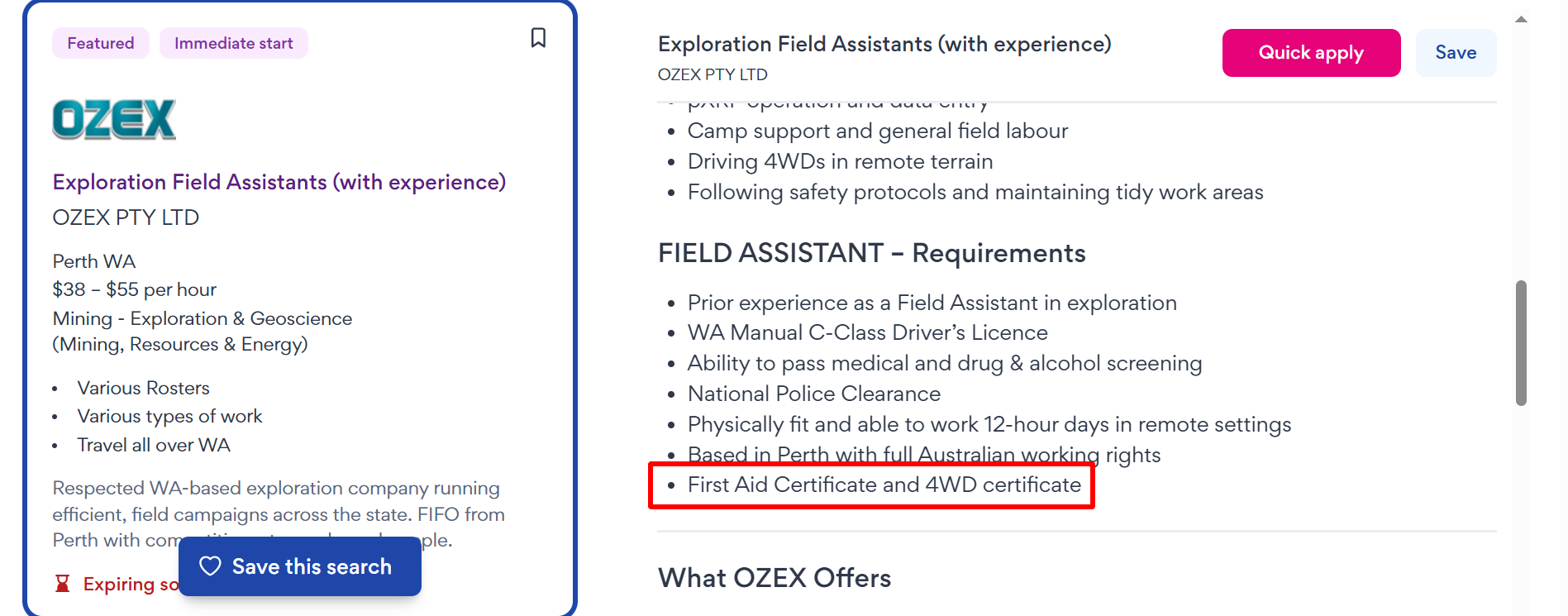
Exploration Field Assistant
“First Aid Certificate and 4WD Certificate” — required.
This is a classic FIFO support role.
You’re not just doing field sampling — you’re:
Working in remote terrain
Driving across uneven ground
Often without a medic close by
Here, First Aid is about being self-reliant.
The expectation is clear: you need to be able to act fast if something goes wrong — especially when you’re hundreds of kilometres from town.
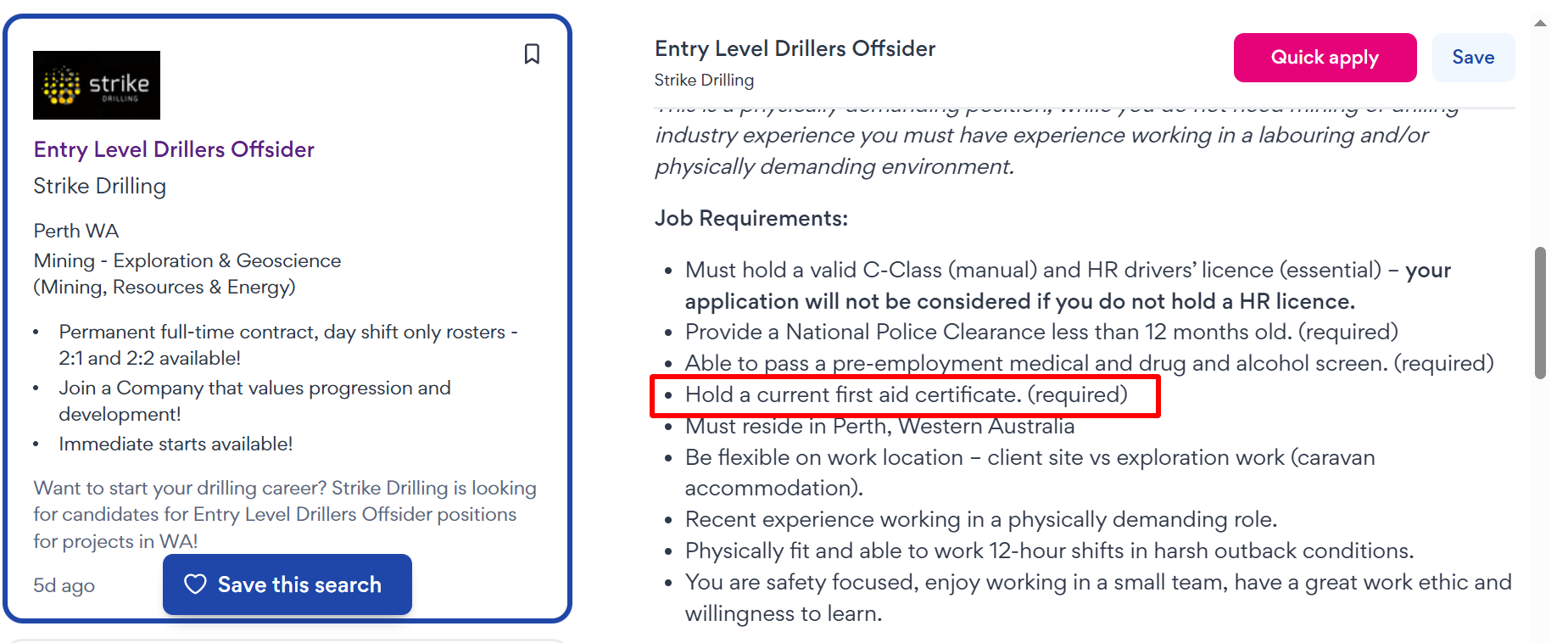
Entry-Level Drillers Offsider – Strike Drilling
“Hold a current First Aid certificate (required)”
No experience needed — but First Aid is non-negotiable. Why?
Because drill sites are:
Physically demanding
Mechanically risky (moving parts, slips, crush injuries)
Often far from emergency services
This role is a foot-in-the-door for many looking to start a mining career.
But they’re not handing out jobs to people who can’t help if something goes wrong.
Getting your cert shows you’re ready to work safely and support your crew.
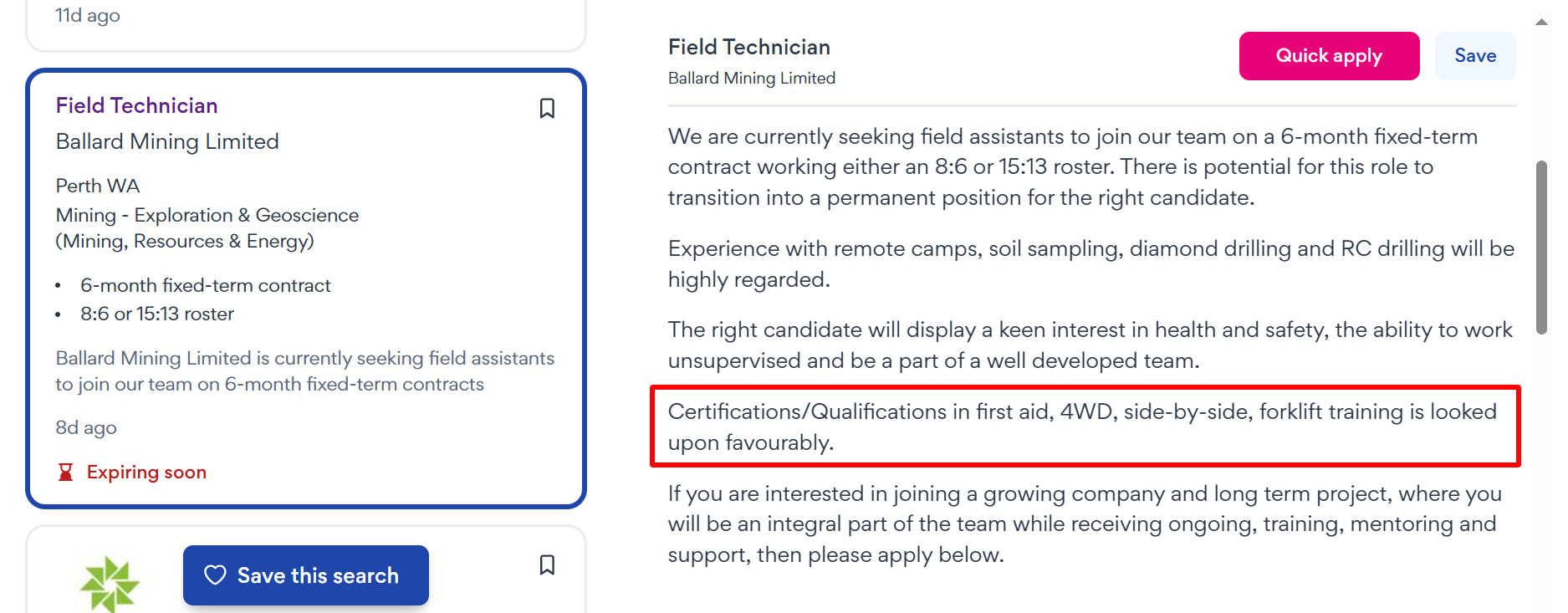
Field Technician
“Certifications in First Aid, 4WD, side-by-side, forklift training looked upon favourably”
This one spells it out: it’s not a hard requirement, but having First Aid makes you a better hire. These field roles are often semi-autonomous, which means:
-
You might be on site without a full team
-
You’re working with equipment and vehicles
-
There’s an expectation you can handle emergencies solo or with minimal help
These are roles where being capable is as important as being certified.

Dump Truck Operator – PMW Industries
“HLTAID011 – Provide First Aid” listed under desirable qualifications
This job pays $51.50 an hour — and First Aid is right there alongside tickets like Working at Heights and Confined Spaces. Why?
Because truckies on mine sites:
-
Work long shifts in hot, isolated environments
-
Face risks like fatigue-related incidents, falls from height, rollovers
-
May be the only person nearby when something goes wrong
Even though it’s “desirable,” having a First Aid certificate is a signal to mining employers: this person is site-ready and takes safety seriously.
Trainer’s Insight
“We train everyone from drillers to admin staff, and the number one surprise we hear is: ‘I didn’t think I’d need First Aid for this role.’ But site-based jobs — even office ones — come with risk. You could be first on scene in a crib room incident, or the only person near a vehicle rollover in the field.
That’s why employers keep listing First Aid, even when it’s not legally required — because when you’re on a remote site, the person standing next to you might be your only help for 30 minutes.”
Why Mining Employers Really Want You to Have First Aid Skills
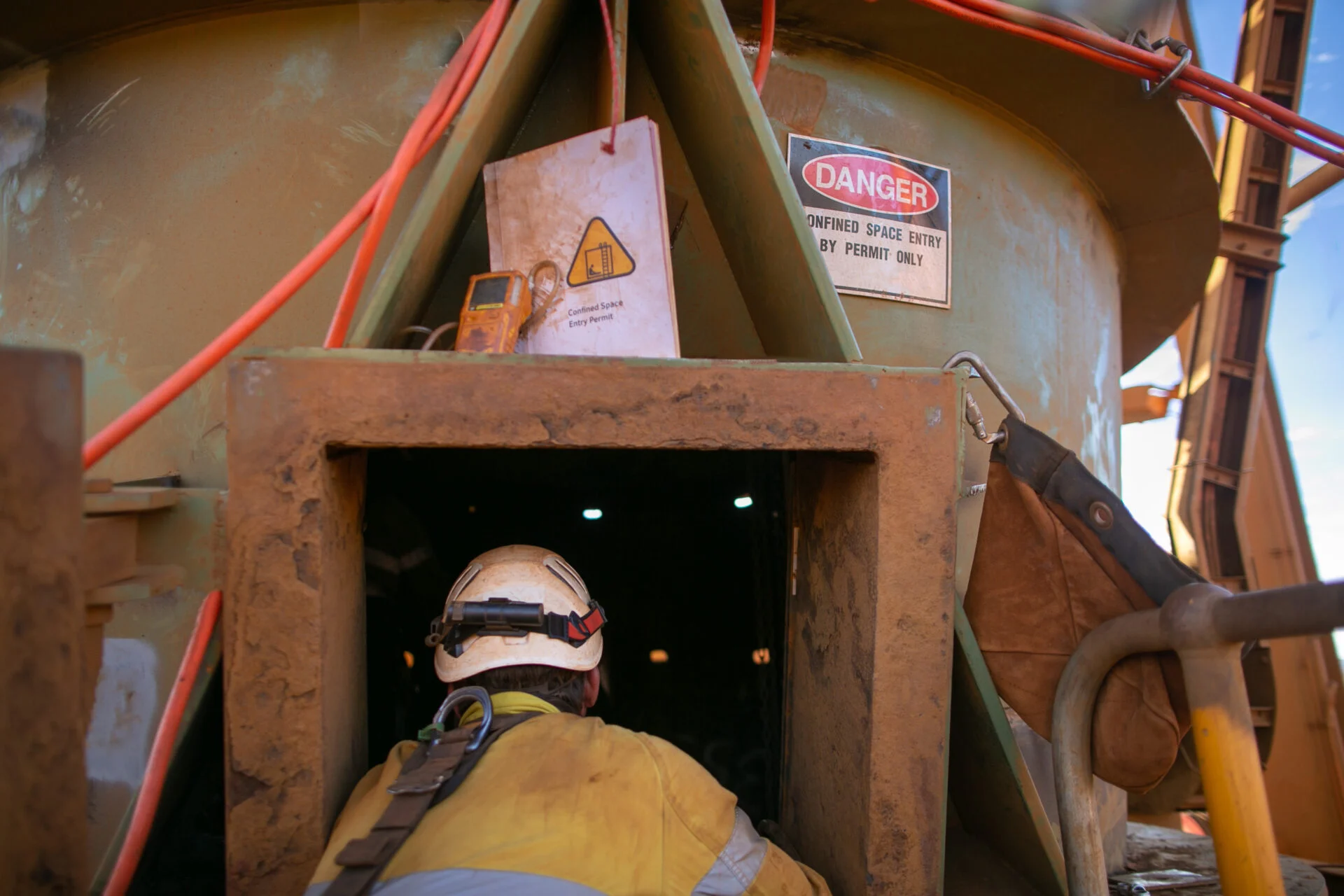
Let’s get one thing straight — not every mining job requires First Aid certification by law.
So why does it show up in so many job ads?
Because employers aren’t just hiring you to do the job — they’re hiring you to be responsible on a high-risk site.
Here’s what that looks like on the ground:
 Remote work means help isn’t close
Remote work means help isn’t close
Whether you’re in admin, operations, or exploration — if you’re on-site and someone collapses, you might be the only person nearby for 10 to 30 minutes. That time matters. Employers want people who know what to do in that window.
 Everyone is part of the emergency plan
Everyone is part of the emergency plan
It’s not just medics and safety officers. Sites train all workers to respond — and if you’re certified, you’re already one step ahead. That makes life easier for the HSE team and shows you’re not a risk to manage — you’re part of the response.
 You’re handling risk, even if you’re not in a “dangerous” job
You’re handling risk, even if you’re not in a “dangerous” job
Driving a 4WD on a dirt road, working next to heavy equipment, lifting in awkward spaces, doing long hours in the heat — these are all low-key dangerous. And when things go wrong, First Aid is the baseline skill that buys time.
 It helps you stand out, especially in entry-level roles
It helps you stand out, especially in entry-level roles
If you’re applying for a Drillers Offsider, Field Assistant, or Dump Truck Operator role — everyone has a licence. But not everyone has First Aid.
When all else is equal, that cert might be what nudges your name to the top of the shortlist.
Trainer’s Insight
“A lot of employers won’t say it outright, but First Aid is a soft filter. It’s one way to spot people who’ve taken initiative — who’ve shown they want to be prepared, not just compliant. Especially in FIFO roles, safety is the culture, and employers don’t want passengers.”
These Mining Jobs Could Be Yours — If You’ve Got a First Aid Certificate
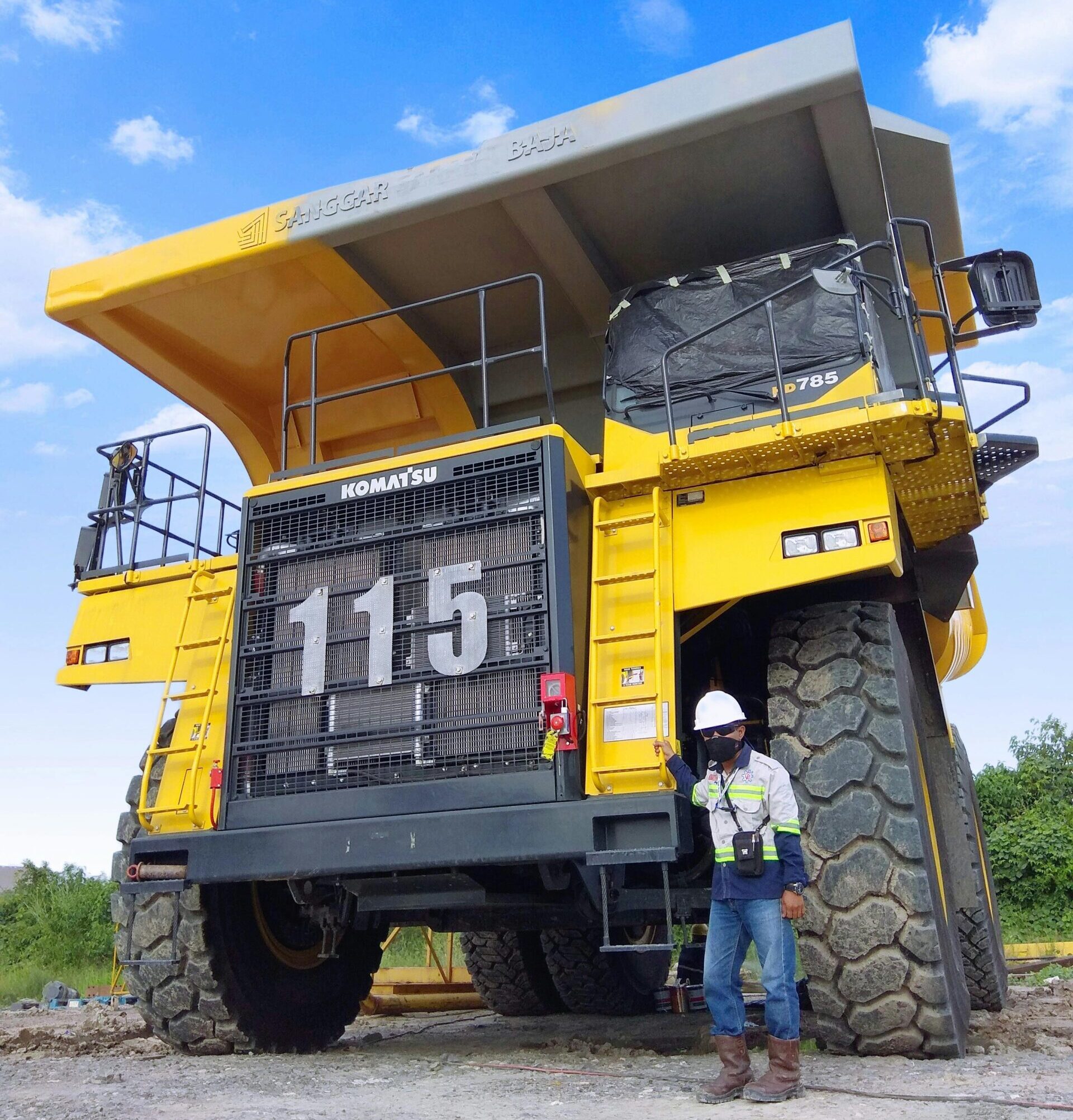
You don’t need to be a medic or safety officer to need First Aid training.
In fact, it’s become a baseline expectation for a wide range of roles across mine sites — not just the high-risk ones.
Here’s a breakdown of the types of jobs where First Aid is often listed as required, favourable, or desirable — and why.
| Job Role | First Aid Requirement | Why It’s Needed |
|---|---|---|
| Drillers Offsider |  Required Required | High-risk manual work, remote sites, machinery — rapid response is critical. |
| Exploration Field Assistant |  Required Required | Remote terrain, limited supervision, heat and vehicle risks common. |
| Field Technician |  Often Favourable Often Favourable | Working alone or in pairs; may need to stabilise injuries before help arrives. |
| Dump Truck Operator |  Often Desirable Often Desirable | Long shifts, fatigue risk, working at height or in isolation. |
| Project Administrator (Site-Based) |  Sometimes Required or Favourable Sometimes Required or Favourable | Often participates in safety procedures, evacuations, or emergency support. |
| Lab Technician / Sample Prep |  Often Required Often Required | Handling chemicals or equipment in isolated lab conditions. |
| Geologist / Field Surveyor |  Required or Favourable Required or Favourable | Independent field work in harsh or isolated environments. |
| Site Cleaner / Utility Worker |  Often Favourable Often Favourable | Works across camps and common areas; may be first on scene in a health incident. |
| Warehouse / Stores Officer |  Sometimes Required Sometimes Required | Involves lifting, forklifts, slips, and mechanical risks. |
| Safety Officer / HSE Advisor |  Always Required Always Required | Expected to lead or support emergency response. |
| Maintenance / Mechanical Roles |  Often Required Often Required | Working with tools, moving machinery, confined spaces, or electrical risks. |
| 4WD Driver / Logistics Support |  Required or Favourable Required or Favourable | Risk of vehicle rollover, long travel hours, isolation from medical help. |
| Camp Admin / Site Receptionist |  Sometimes Favourable Sometimes Favourable | Even non-physical roles may be called on to assist in site-wide incidents. |
From hands-on roles to support positions, First Aid shows up because emergencies don’t discriminate.
If you’re the first one on scene — or even just nearby — employers want to know you’re prepared to act.
Trainer’s Insight
“What surprises most people is how often First Aid is useful in completely ‘non-hands-on’ roles. We’ve had camp receptionists and warehouse staff use their training in real incidents before the site medic even arrived. Out here, everyone’s part of the safety team, whether they realise it or not.”
What First Aid Certificate Do You Actually Need?
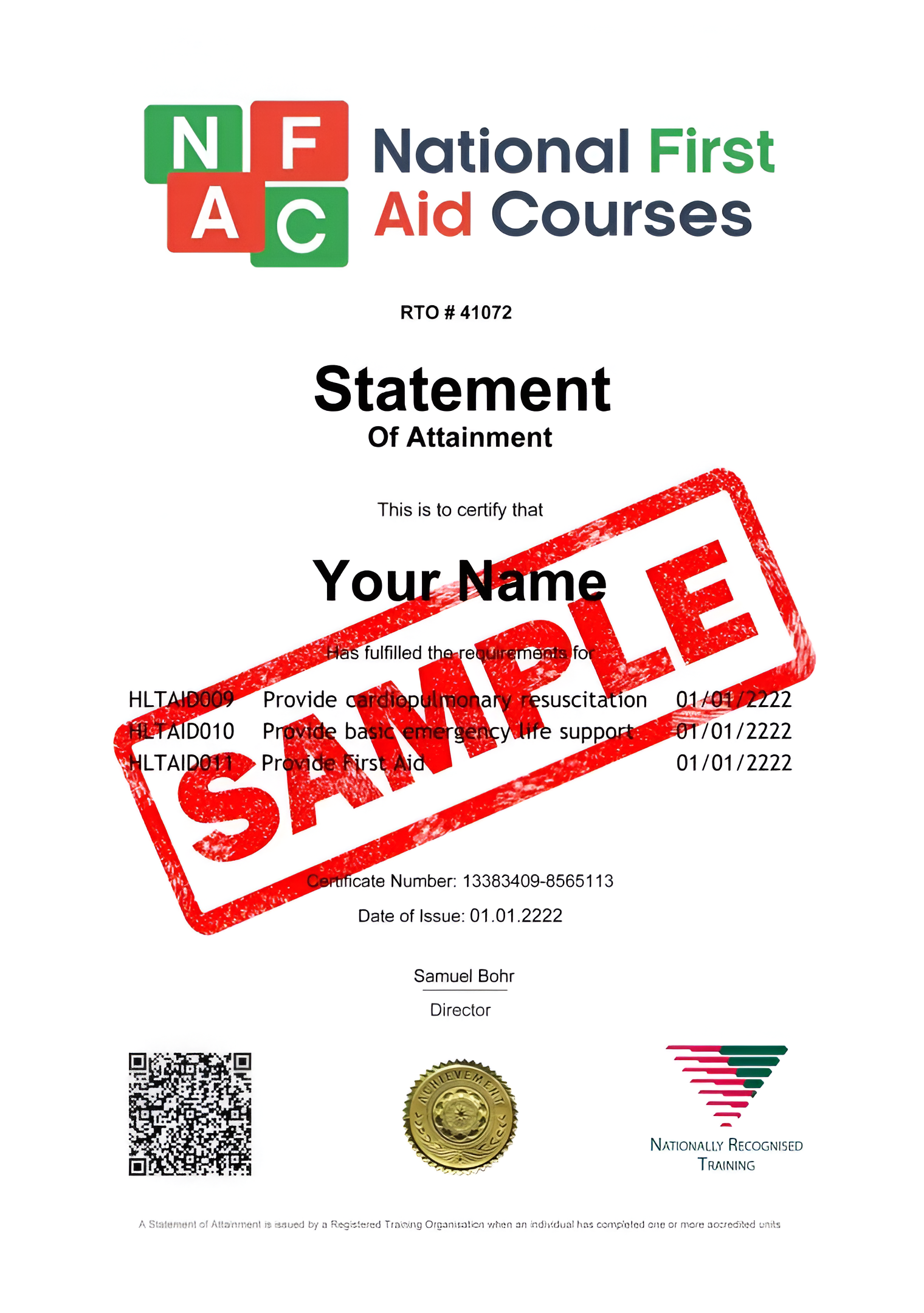
When mining job ads mention First Aid certificates, they’re almost always referring to HLTAID011 – Provide First Aid.
This is the nationally recognised certificate that covers the core skills every employer expects you to have on site. It’s not a long or difficult course — but it does cover serious ground.
Here’s what’s included:
 What You’ll Learn in HLTAID011 – Provide First Aid
What You’ll Learn in HLTAID011 – Provide First Aid
-
How to assess and respond to emergency situations
-
CPR (including use of an AED — defibrillator)
-
Managing shock, bleeding, fractures, burns, asthma, anaphylaxis, seizures, heat stroke, and more
-
Site-specific scenarios like electrical injuries, crush injuries, and remote-area response
It’s designed for workplace emergencies, which is exactly why mining and FIFO employers list it in their hiring criteria.
How Long Does the First Aid Course Take?
Most people complete the training in one day.
And yes — you usually get your certificate on the same day.
What You’ll Walk Away With
-
Nationally recognised certification (valid in every state and territory)
-
Meets requirements for mining, construction, security, and other regulated industries
-
Certificate is valid for 3 years (CPR component refreshed annually)
This isn’t just a box to tick or a nice-to-have on your resume.
It’s a practical skill that boosts your chances of getting hired — and makes you more valuable once you’re on the job.
Trainer’s Insight
“Some people put off First Aid thinking it’s a big commitment, but it’s one of the shortest, most valuable courses you can do to get job-ready. In the mining industry — it shows you know the basics and that others can rely on you in a crisis.”
How to Get First Aid Certified (Without Wasting Time or Money)
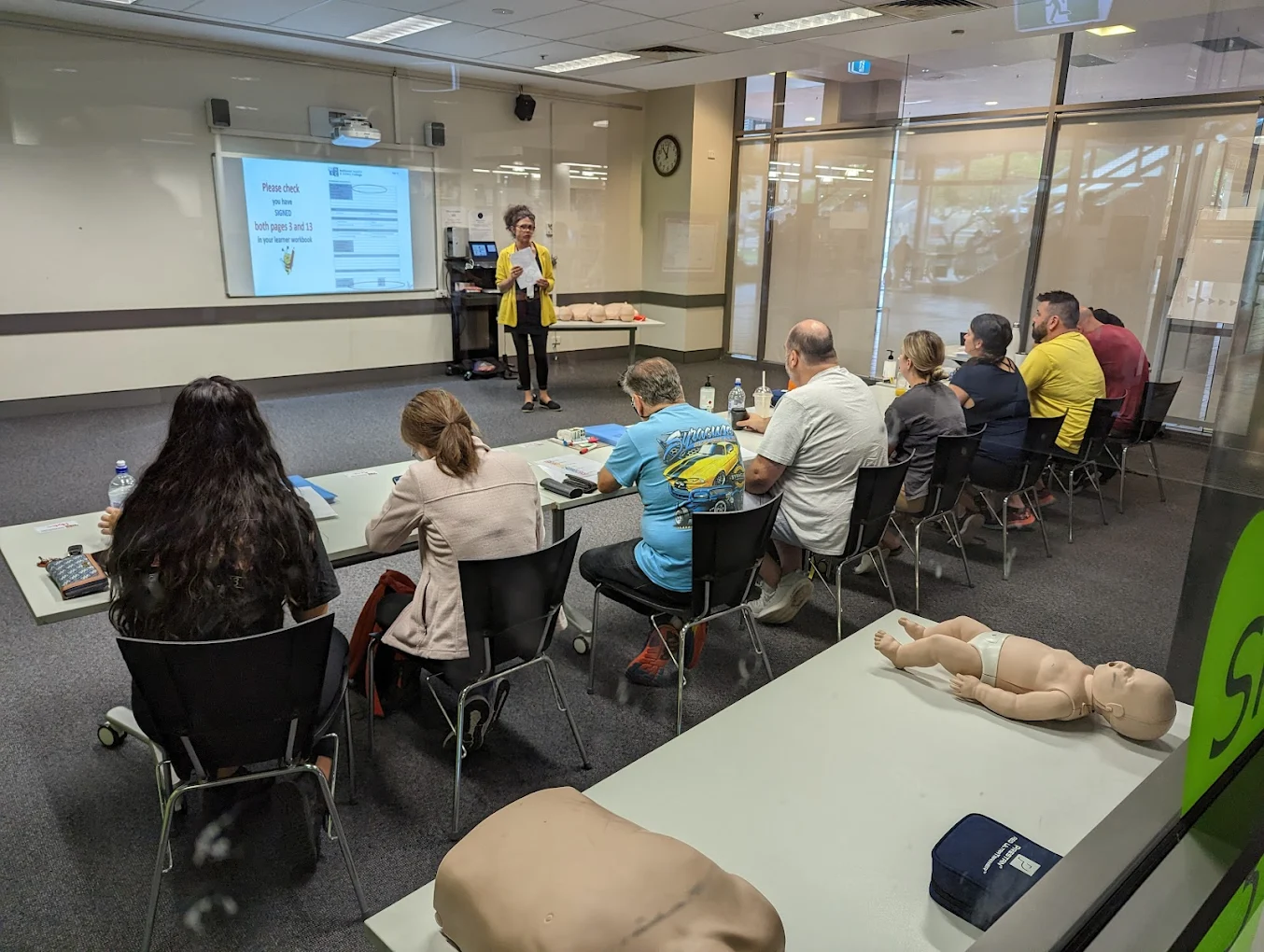
If you’re ready for a job in mining and all that’s holding you back is First Aid, the fastest path forward is in-person, face-to-face training — just like mine sites expect.
At National First Aid Courses, we deliver 100% face-to-face First Aid training across Australia.
That’s because in high-risk industries like mining, hands-on confidence matters more than clicking through online slides.
Here’s Why Face-to-Face Training Matters:
You’ll actually practice the skills — not just read about them
Trainers can correct your technique in real time (especially for CPR and defib use)
You’ll feel more prepared to act under pressure — because you’ve already done it
It aligns with what mine sites expect: practical, job-ready training
What You Get:
HLTAID011 – Provide First Aid (the one employers ask for)
Nationally recognised certificate
Same-day certification in most locations
Delivered by professional trainers with real-world experience on site
It’s fast, straightforward, and designed to give you real confidence — not just a certificate.
Trainer’s Insight
“Online First Aid might get you a piece of paper, but it won’t hold up under pressure. When someone’s unconscious or choking, you want muscle memory — not browser history. Face-to-face is the only way to train people to respond like it’s second nature.”
Final Word: First Aid Certification Matters In The Australian Mining Industry
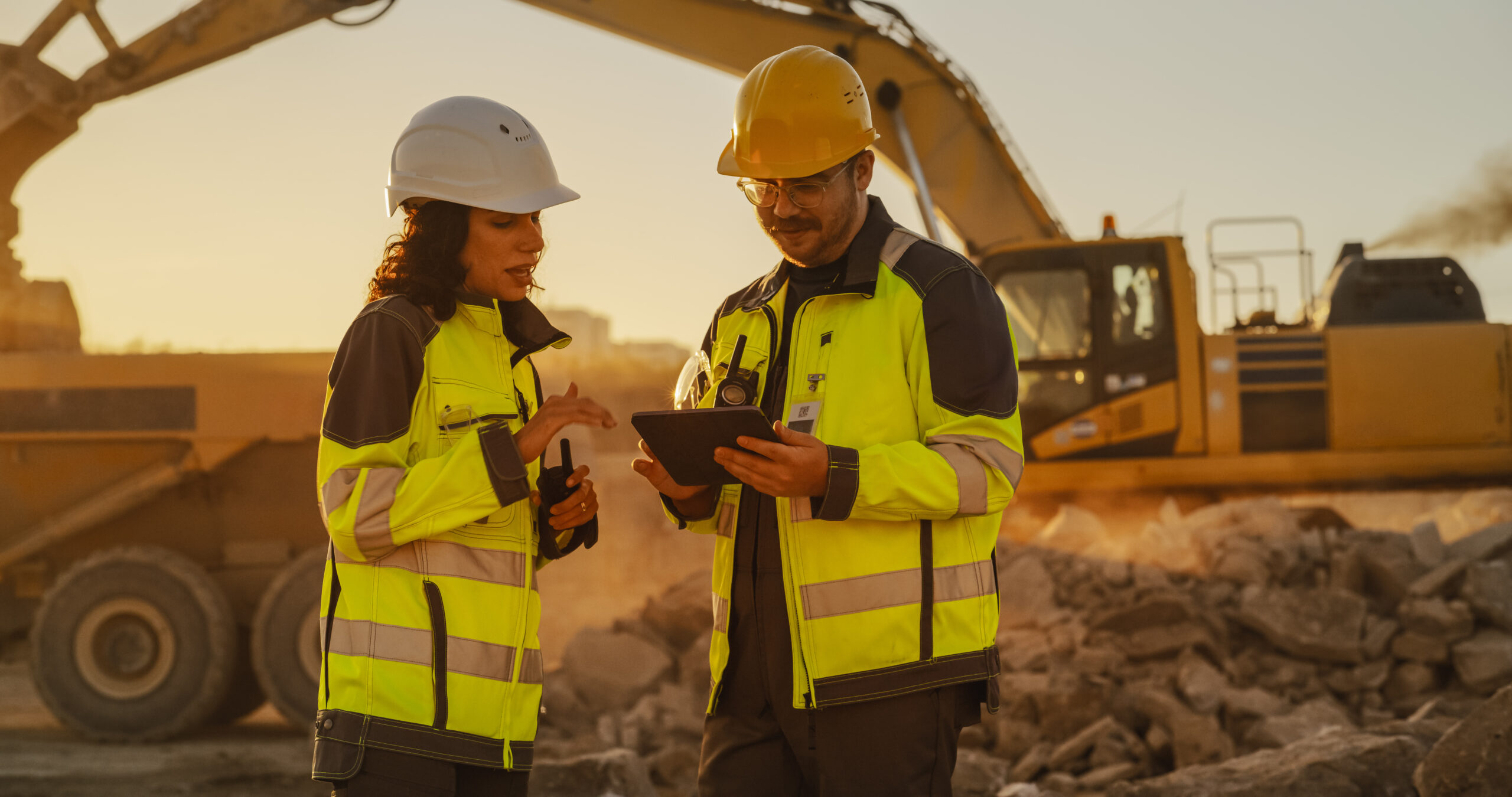
Breaking into the mining industry isn’t about luck. It’s about being ready when the opportunity shows up.
And time after time, a First Aid certificate is one of the things employers are quietly checking for — whether it’s listed as required or just favourable.
In some cases, your application won’t even reach a human if the right certifications aren’t ticked in the automated system.
That’s why on platforms like SEEK or Indeed, missing a First Aid certificate can mean your resume is filtered out before anyone sees it — even if you’re otherwise the perfect fit.
So if you’ve been:
Waiting for a way to stand out in a sea of applicants,
Applying for FIFO or entry-level roles and not getting replies,
Or just one ticket away from being site-ready
Then getting your First Aid certification might be the easiest win of your job hunt.
It takes a day. It lasts three years. And it could be the reason your phone starts ringing.
Trainer’s Insight
“Most jobseekers think experience is the barrier — but often, it’s missing paperwork. I’ve had students get interviews within 24 hours of uploading their First Aid cert. Employers want people who are ready to step on site — and First Aid says, ‘I’m ready.’”
FAQ: First Aid for Mining Jobs
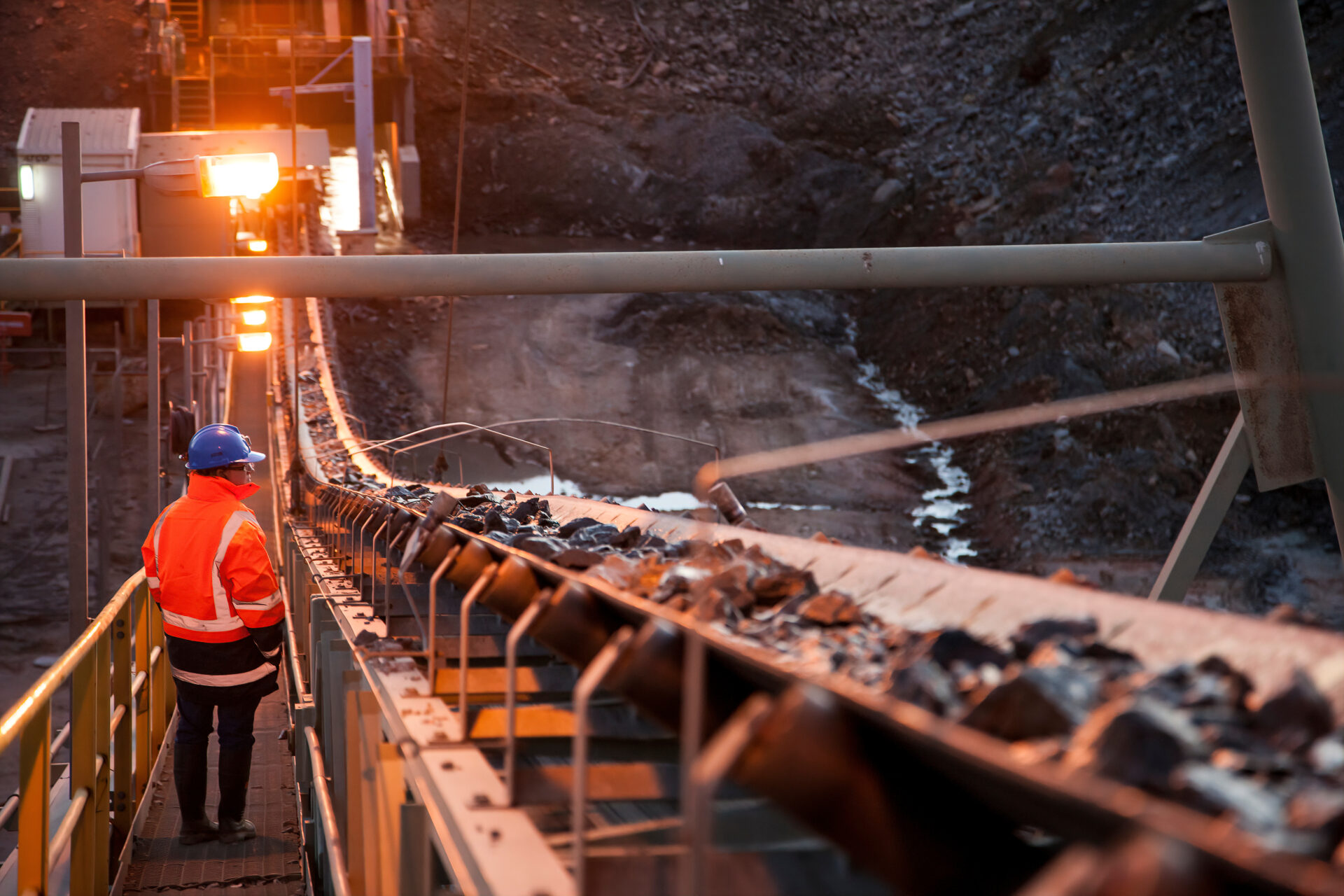
1. I’ve never worked in mining — will First Aid help me get my foot in the door?
Yes. First Aid is one of the few industry-relevant tickets that doesn’t require prior experience but still shows employers you’re serious about safety and ready to be part of a crew. It helps you stand out, especially in entry-level roles.
2. Do I need a First Aid certificate even if I’m not doing physical work?
Often, yes. Even if your role is admin-based or support-focused, you’ll still be working on site. If there’s an incident, anyone nearby may be expected to assist until help arrives. Employers value staff who can step in and respond.
3. Can I just do CPR instead of the full First Aid course?
CPR training (HLTAID009) is useful, but most mining employers are specifically looking for HLTAID011 – Provide First Aid. It includes CPR plus training for things like burns, fractures, shock, and heat-related illness. If you’re going to do one, HLTAID011 covers more ground and meets more job requirements.
4. What if I did First Aid years ago — does it still count?
Probably not. Most employers want a current certificate issued within the past three years. If you’re applying now, it’s worth updating your training to make sure it’s valid and recognised.
5. Will I have to pass a test or exam?
There’s no written exam, but you will need to demonstrate skills like CPR, wound management, and response scenarios. Our trainers walk you through everything. If you pay attention and engage, most people pass easily.
6. Will employers actually check if I have the certificate?
Yes. Many companies request your certificate before induction or medical clearance. On job sites like SEEK, applications can be automatically filtered out if you haven’t ticked First Aid as a qualification.
7. Can I get a job offer first and do the training later?
In some cases, yes — but it’s not ideal. We’ve seen people lose roles because they couldn’t supply their certificate fast enough before mobilisation. If you’re job-hunting now, it’s smart to get it done ahead of time so you’re not caught out.
Get Government-Approved First Aid Training at a Location Near You!
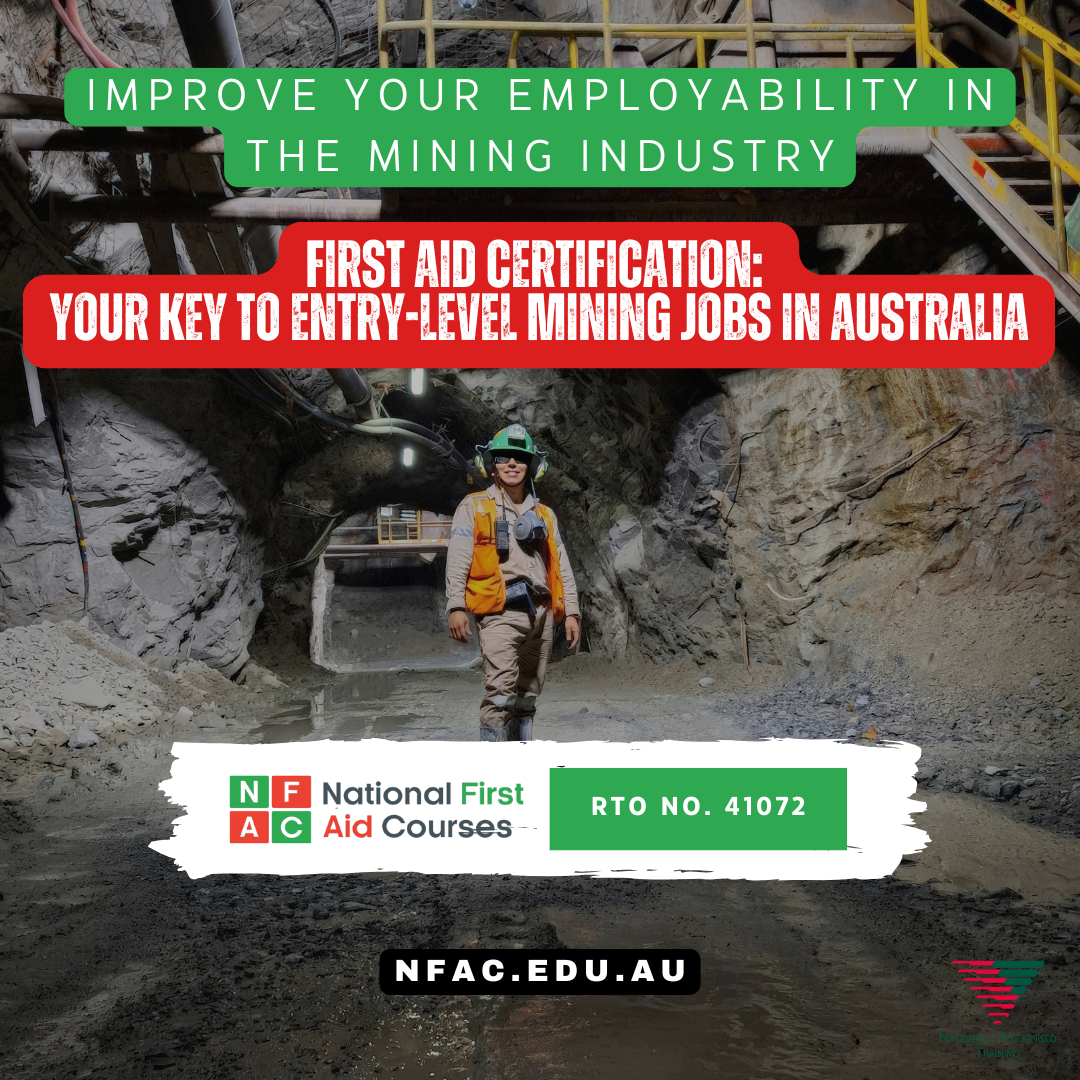
Ready to walk onto site with the skills employers actually look for?
Start with the First Aid certificate that mining supervisors want to see — delivered face-to-face by National First Aid Courses, Australia’s trusted provider of nationally recognised training.
As a Registered Training Organisation (RTO 41072), we specialise in hands-on, practical first aid courses designed for real workplace emergencies — not theory-heavy online modules.
With same-day certification, in-person training, and locations across Australia, it’s the fastest way to get job-ready and stay ahead in the recruitment process.
Whether you’re heading for FIFO, looking to stand out in entry-level roles, or just want to be ready when it counts — this is the qualification that can get you through the filter and onto site.
Book your HLTAID011 – Provide First Aid course with National First Aid Courses and take the next step toward site readiness today.
On This Page
- Why You’re Probably Closer to Mining Than You Think
- The Hidden Ticket Employers Keep Asking For
- Why Mining Employers Really Want You to Have First Aid
- These Jobs Could Be Yours — If You’ve Got First Aid
- What First Aid Certificate Do You Actually Need?
- How to Get First Aid Certified (Without Wasting Time or Money)
- Final Word: You Don’t Need Experience — You Need to Be Ready
- FAQs: First Aid for Mining Jobs
Author Bio:

Jacqueline Lisa
Manager and Accredited First Aid Trainer at National First Aid Courses (NFAC)
With over a decade of experience in the childcare and aged care industries, Jacqueline has dedicated her career to applying her First Aid knowledge in real-world settings. As an accredited First Aid trainer and manager at National Courses PTY LTD, Jacqueline is committed to delivering nationally recognised First Aid and CPR courses across Australia. She combines her hands-on experience with a passion for teaching, empowering others with the critical skills needed to make a difference in emergency situations.
Connect on Social Media
Contact Us For Assistance
- 1300 623 613
- admin@nfac.edu.au
- Monday to Friday: 8:30 am – 4:30 pm
Share This Article:
Related Articles:
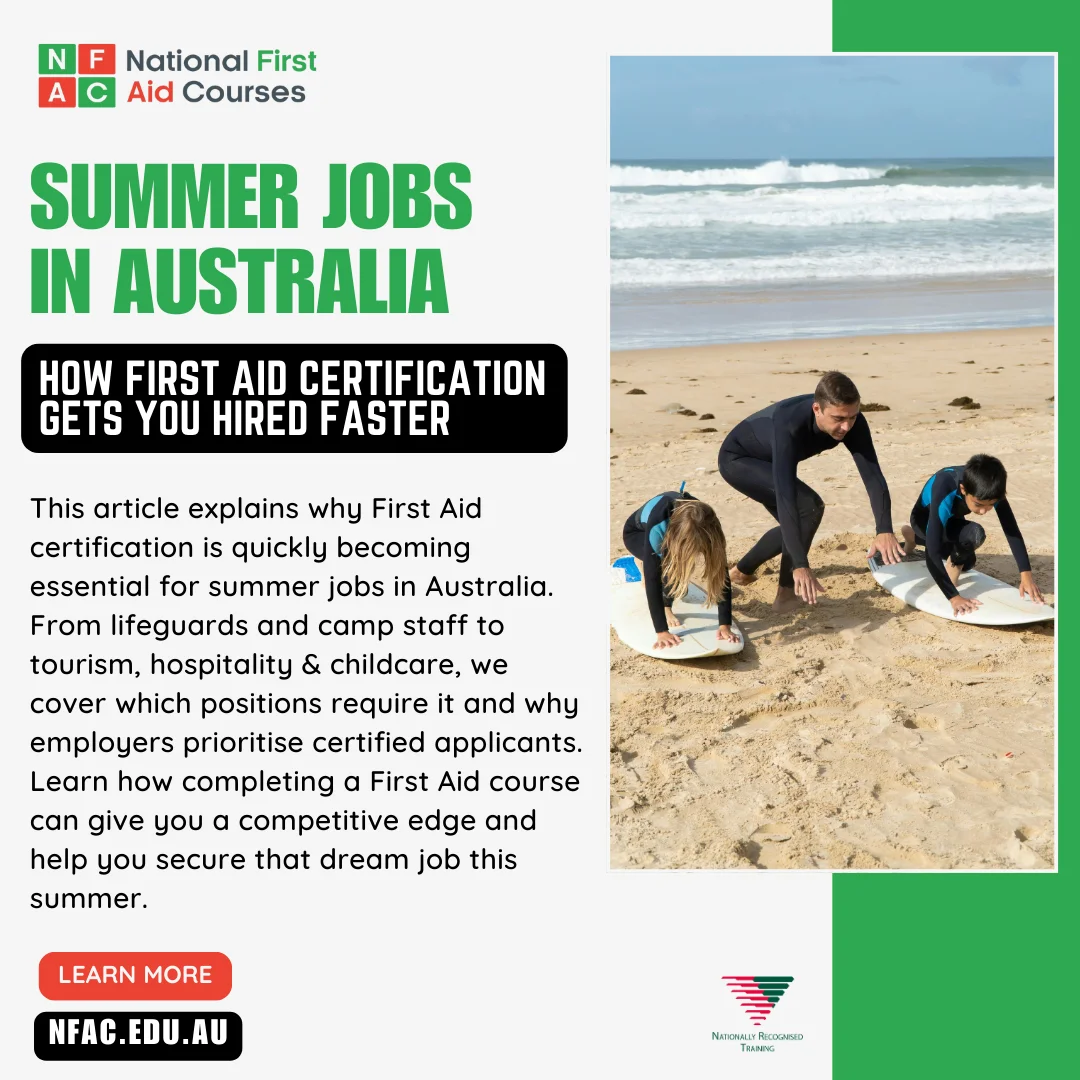
Popular Summer Jobs in Australia: How First Aid Training Can Get You Hired
In this article, we look at why First Aid and CPR training is a must-have skill for anyone volunteering at summer events across Australia. From community festivals to sports carnivals and charity fundraisers, we cover the safety expectations, heat-related risks, and the accredited training that ensures you’re ready to act fast when emergencies strike in the summer heat.
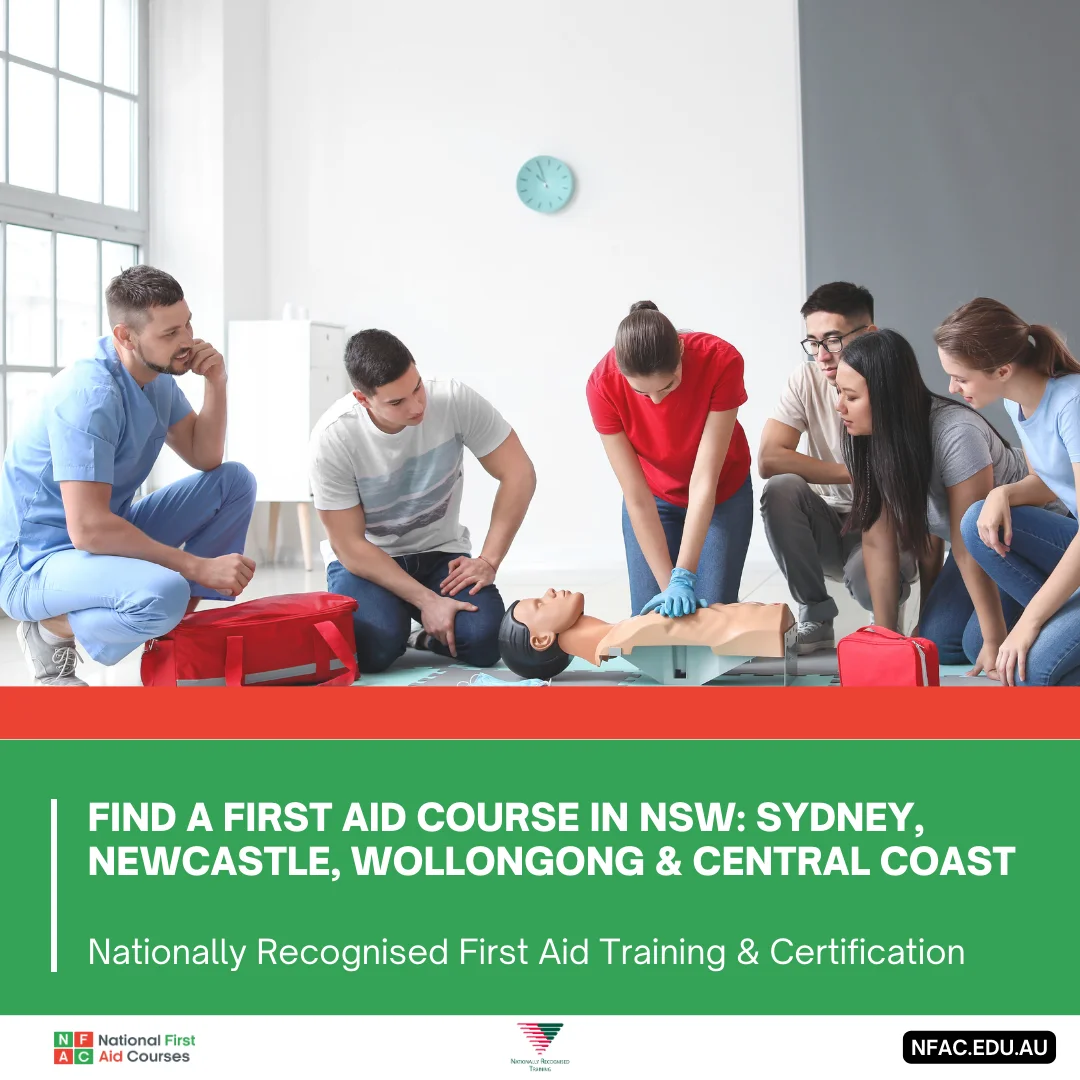
Find a First Aid Course in NSW: Sydney, Newcastle, Wollongong, Central Coast & More
In this guide, we’ll show you exactly how to find the best First Aid course in New South Wales — whether you’re in Sydney, Newcastle, Erina, or Wollongong. From understanding accredited training requirements to comparing face-to-face vs online options, you’ll learn what matters most before booking. Plus, we’ll share tips for choosing a provider that guarantees practical, hands-on skills you can trust in an emergency.
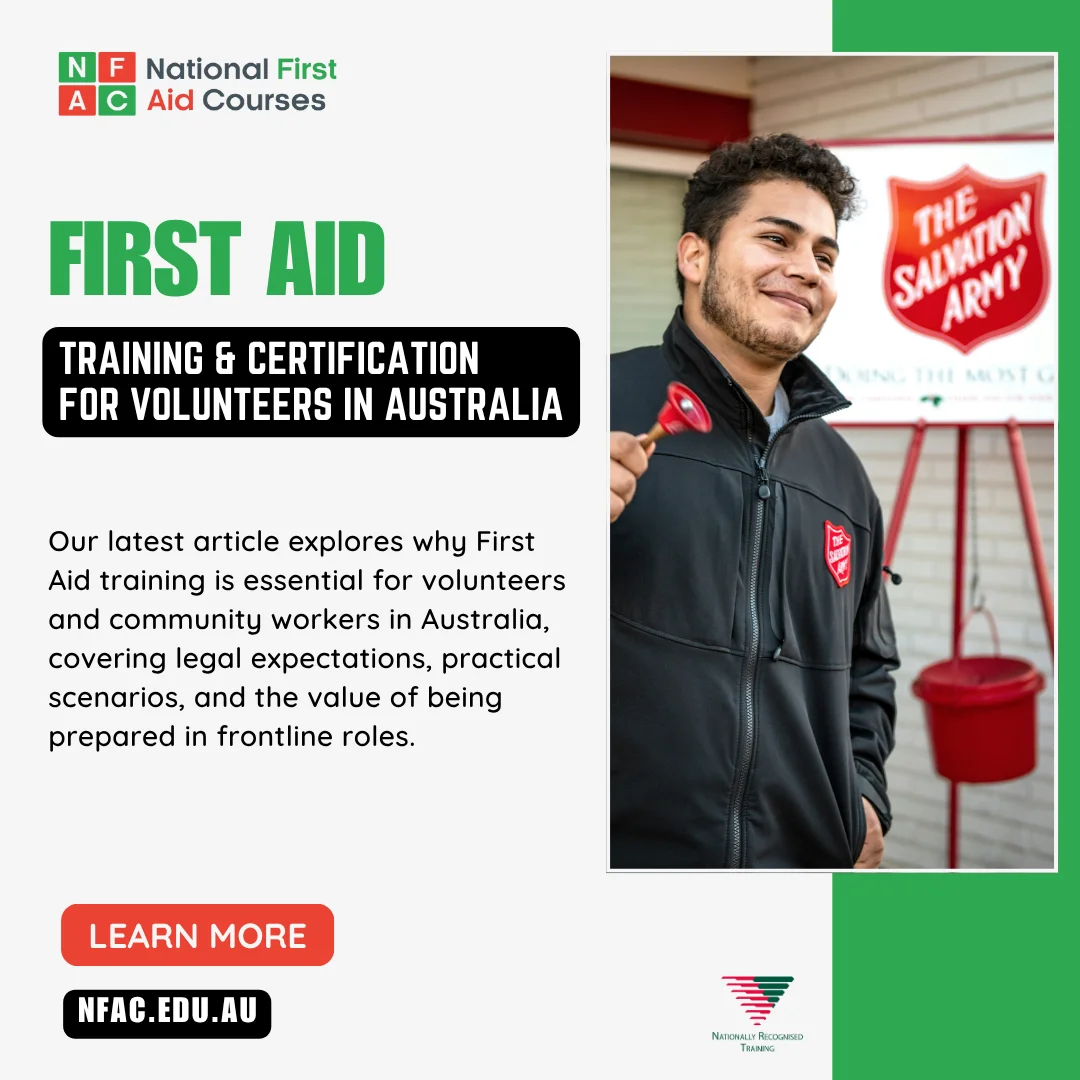
Do Volunteers and Community Workers in Australia Need First Aid Training? What the Rules Say
In this article, we explore why First Aid and CPR training is becoming essential for volunteers across Australia — not just a bonus. Whether you’re helping out at a school, charity event, or aged care centre, we break down the legal requirements, expectations from organisations, and the nationally recognised training that prepares you to step in when it counts.
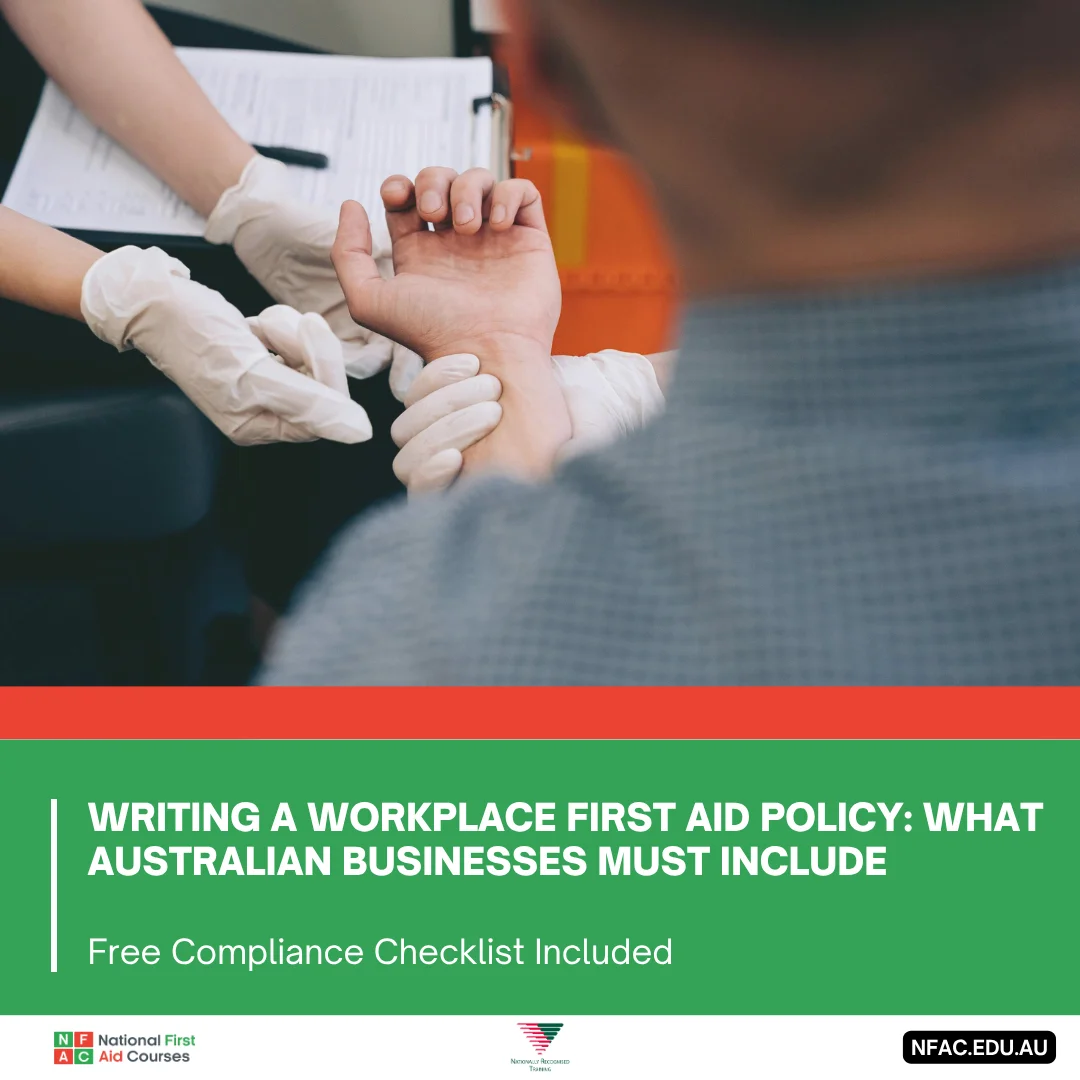
In this guide, we’ll walk you through why every Australian workplace needs a formal First Aid policy — and what should be included to meet WHS standards. From legal requirements to training and kit checklists, you’ll learn how to turn policy into real-world readiness.
